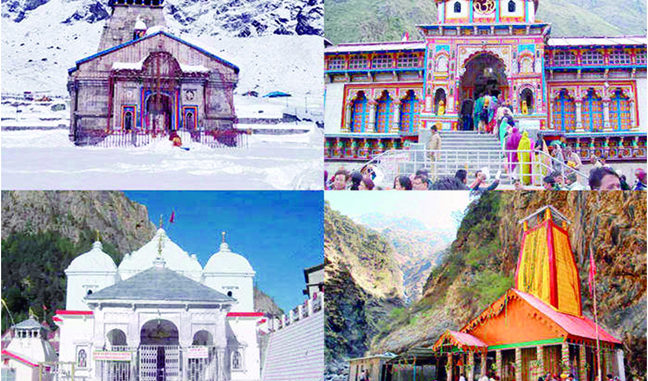
There are four holy shrines in Uttarakhand dedicated to Hindu Gods and holy rivers of India. The four shrines are situated within the Garhwal Region. These are collectively referred as “Char Dhaam of Uttarakhand” . Pilgrims from all over India and abroad visit the shrines as “Char Dhaam Yatra”. In Hindu religion, Char Dhaam Yatra holds has great importance and sanctity. It is believed that every Hindu should undertake Char Dhaam Yatra at least once in a life time to avail the blessings of gods adorning the shrines.
Char Dham Yatra 2021
As per Covid-19 pandemic guidelines, pilgrims/devotees cannot visit Uttarakhand Char Dham yatra-2021 in person till further notice. But they can book online for Puja / Path / Archna /Arti / Bhog etc with online payment through this portal, which will be performed on their behalf by chief priest of temple on the given date with their name and gotra.
The Char Dham (meaning four abodes) is a set of four pilgrimage sites in India. It is believed that visiting these sites helps achieve moksha (salvation). The four Dhams are Badrinath, Dwaraka, Puri and Rameswaram.
It is believed that every Hindu should visit the Char Dhams during one’s lifetime. The Char Dham as defined by Adi Shankaracharya consists of four Hindu pilgrimage sites. Another small circuit in Uttarakhand of four pilgrimage sites: Yamunotri, Gangotri, Kedarnath, and Badrinath is referred to as Chota Char Dham.
Yamunotri
The Shrine of Yamunotri at the source of river Yamuna. Atop is a flank of Bandar Poonch peak (3615 meters). The actual source, a frozen lake of ice and glacier (Champasar Glacier) located on the Kalind Mountain at the height of 4421 m above sea level is about 1 km further up is not easily accessible. Hence the shrine has been located on the foot of the hill. The Temple of divine mother Yamuna was built by Maharaja Pratap Shah of Tehri Garhwal. The tiny Yamuna has icy cold water and its absolute innocence and the infantile purity heightens that deep feeling of reverence, which Yamunotri has for the devout. According to the legend ancient sage Asit Muni had his hermitage here. The trek to Yamunotri is truly spectacular, dominated by a panorama of rugged peaks and dense forests.
The deity or Goddess Yamuna is made of black marble. The temple is dedicated to the river Yamuna, who is represented in the form of a silver idol, bedecked with garlands.
Close to the temple are hot water springs gushing out from the mountain cavities. Suryakund is the most important Kund. Near the Suryakund there is a shila called Divya Shila, which is worshipped before puja is offered to the deity. Pilgrims prepare rice and potatoes to offer at the shrine by dipping them in these hot water springs, tied in muslin cloth. Rice so cooked is taken back home as prasadam.
Gangotri
Gangotri is one of the origin sources of Holy River Ganga (Ganges), and one of the important Char Dham pilgrimage in Hindu Religion. The main origin of the river is Gaumukh which is a glacier located 19 km away from gangotri temple. Ganga river is the longest and most sacred river in world.
The Gangotri temple was built by the Gorkha General Amar Singh Thapa, in the 18th century and is situated on the left bank of Bhagirathi river. The temple is nested amidst the beautiful surroundings of deodars and pine trees. It lies close to the holy rock or the Bhagirath Shila where King Bhagirath had worshiped Lord Shiva. The Gangotri temple is dedicated to Goddess Ganga.
The Pujaris and Priests who perform in the temple belong to the village of Mukhwa. The water from Gangotri is carried to offer to Lord Shiva. It is believed that this water has nectar in it and will soothe the throat of Shiva who gulps the poison.
Kedarnath
Kedarnath temple is one of the sacred pilgrimage centre in Northern India, located on the bank of Mandakini river at an altitude of 3584 meters above sea level. The historical name of this region is “Kedar Khand”. Kedarnath temple is a part of Char Dhams and Panch Kedar in Uttarakhand and one of the 12 Jyotirlingas of Lord Shiva in India.
There are more than 200 shrines dedicated to Lord Shiva in Chamoli district of Uttarakhand itself, the most important one is Kedarnath. According to legend, the Pandavas after having won over the Kauravas in the Kurukshetra war, felt guilty of having killed their own Kith and Kin and sought blessings of Lord Shiva for redemption. He eluded them repeatedly and while fleeing took refuge at Kedarnath in the form of a bafellow.
On being followed, the Lord dived into the ground, leaving his hump on the surface at Kedarnath. The remaining portions of Lord Shiva appeared at four other places and are worshipped there as his manifestations. The arms of the Lord appeared at Tungnath, the face at Rudranath, the belly at Madmaheshwar and his locks (hair) with head at Kalpeshwar. The Kedarnath and four above mentioned shrines are treated as Panch Kedar (Panch means Five in Sanskrit). The Temple at Kedarnath presents an imposing sight, standing in middle of a wide plateau surrounded by lofty snow covered peaks. The temple was originally built in 8th century A.D. by Jagad Guru Adi Shankaracharya and stands adjacent to site of an even earlier temple built by the Pandavas. The inner walls of the assembly hall are decorated with figures of various deities and scenes from mythology. Outside the temple door a large statue of the Nandi Bafellow stands as guard.
Dedicated to Lord Shiva, the Kedarnath temple has exquisite architecture Built of extremely large, heavy and evenly cut grey slabs of stones, it evokes wonder as to how these heavy slabs were moved and handled in the earlier centuries. The temple has a Garbha Griha for worship and a Mandap, apt for assemblies of pilgrims and visitors. A conical rock formation inside the temple is worshipped as Lord Shiva in his Sadashiva form.
Badarinath
Badarinath is one of the holy shrines for Vaishnavites among the 108 divya desams incarnation of Lord Vishnu. Badrinath town is also the part of Panch Badri temples including Yog Dhyan Badri, Bhavishya Badri, Adi Badri and Vriddha Badri, along with Badrinath temple.
The main entrance gate of Badarinath temple is colourful and imposing popularly known as Singhdwar. The temple is approximately 50 feet tall with a small cupola on top, covered with a gold gilt roof. The Badarinath temple is divided into three parts (a) The Garbha Griha or the sanctum sanctorum (b) The Darshan Mandap where rituals are conducted and (c) The Sabha Mandap where pilgrims assemble.
At the Badarinath Mandir Gate, directly opposite the main Idol of Lord himself, is seated idol of Bird Garud, vehicle / carrier of Lord Badarinarayan. Garud os seen is sitting position and in prayer with his hands folded. The walls and pillars of the mandapa are covered with intricate carvings.
The Garbha Griha portion has its canopy covered with a sheet of gold and houses Lord Badari Narayan, Kuber (God of wealth), Narad rishi, Udhava, Nar and Narayan. The complex has 15 idols. Especially attractive is the one-metre high image of lord Badarinath, finely sculpted in black stone. According to legend Shankara discovered a black stone image of Lord Badarinarayan made of Saligram stone in the Alaknanda River. He originally enshrined it in a cave near the Tapt Kund hot springs. In the sixteenth century, the King of Garhwal moved the murti to the present loction of the temple. It represents Lord Vishnu seated in a meditative pose called Padmasan.





Be the first to comment